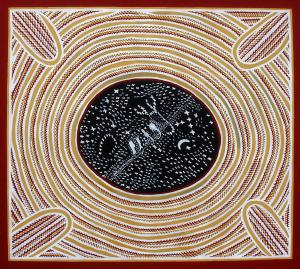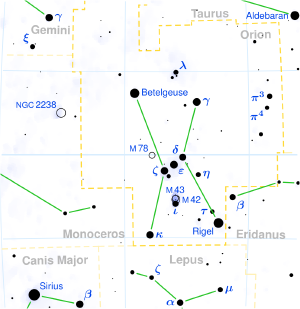Blog
The Old Names
16 March 2021
 Bill Yidumduma Harney
Bill Yidumduma HarneyHumans have given names to stars throughout history. Humans reflect their cultures in the sky, and therefore star names and constellation names show us the tapestry of human diversity. But most of the names used in modern astronomy draw upon a small fraction of that heritage.
The official names for stars are derived from the star atlas Uranometria, which was published by German astronomer Johann Bayer in 1603. Bayer formalized stellar designations by assigning all stars to a constellation. Stars in each constellation were then arranged by brightness, and assigned a Greek letter in alphabetical order. Thus Betelgeuse, the brightest star in Orion, was designated α Orionis. Bellatrix is γ Orionis because it is the third brightest star in Orion.
 Torsten Bronger
Torsten BrongerUranometria is based on earlier catalogs, such as the star catalog of Tycho Brahe, and Johannes Kepler’s Rudolphine Tables, as well as even earlier works such as Ptolemy’s Almagest. Because of this history, most of the common star names in use are derived from Arabic, Latin, and Greek culture. Thus we have names such as Rigel, which is Arabic for “leg or foot,” and Capella, which is Latin for “small female goat,” and Sirius, which is Greek for “glowing orb.”
For years the International Astronomical Union (IAU) only used the designations of stars, not the common names. But in 2016 the IAU began to recognize certain historical names. This included many of the names we know, such as Polaris for the north star, and Vega for the bright star of the summer triangle, but it also includes names from cultures beyond the popular three. For example, Xamidimura, the “eyes of the lion” as named by the Khoikhoi people of South Africa, and Pipirima, from a Tahitian legend.
The IAU now officially recognizes 313 names, including some of the earliest names from the Wardaman people in Australia’s Northern Territory. These include Larawag, the signal watcher, and Ginan, which represents a bag filled with songs of knowledge. Aboriginal cultures in Australia trace their roots back some 65,000 years. The names drawn from these cultures are perhaps the oldest human names for stars we still have.
These cultural names for stars don’t need IAU approval to make them valid or real. They are a part of our human culture, with a richness equal to the more popular names most of us know. But by recognizing these star names the IAU acknowledges the long history of human astronomy that has existed and still exists all over the world. Astronomy is not a product of the western world. It is a deeply human activity. Humans were astronomers long before some were Europeans, and it’s good to see that the names we use in modern astronomy are starting to acknowledge that.
You can find the offical list of IAU star names here.